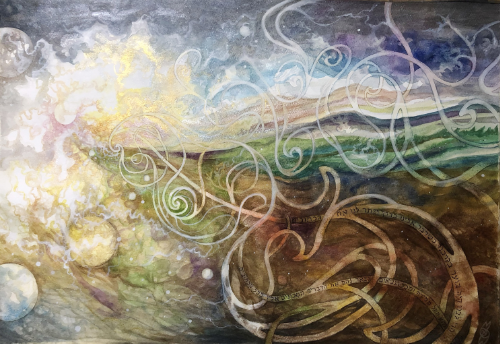March 2021
This intriguing painting was commissioned by someone who liked my interweaving drawings and watercolours. He wanted something similar, to express – in an abstract sort of way – the part of the Gospel of Luke that talks about the road to Emmaus, in Luke 24. He works in a Bible College and was wanted an artwork that represents his interests in a visual way. This article naturally contains some theology and biblical philosophy as well as the artistic process underpinning it.
Painting the invisible
This part of the Bible is where the resurrected Messiah appears to some disciples who were walking along this road out of Jerusalem towards a place called Emmaus. He “expounded” or explained to them from the Scriptures all the things concerning himself, beginning at Moses and all the prophets. What we wanted to capture in this artwork was not so much an illustration of the scene but something that brings the mental and spiritual process to the forefront.
In my mind’s eye I could see the Messiah talking and helping the disciples “unravel and unwind” what had previously been confusing to them. He took them back to their memories of Moses and the Prophets’ predictions and helped them to see how the formation of the Jewish people had paved the way for the purpose and the arrival of the Messiah. I could see him filling in the gaps, leading them on a journey of discovery and revelation. I used my intuitive, seemingly abstract artistic process to reflect these thoughts: the interweaving lines growing outward from one point using sacred geometry underneath.

There also needed to be an idea of a landscape and a vanishing point, just to help our human side understand the setting and give the idea of the “road”, and the earthy tones in the bottom right is supposed to reflect the earthiness/simplicity of man contrasting and blending with the glorious complexity and holiness of God.
Hebrew verses
The client wanted a hint of the verses in the artwork, but not dominating. Even though the New Testament was written mainly in Greek, Hebrew was the language of the Torah and prophetic writings, and they would have spoken in Aramaic. Since I studied and spoke Hebrew as a young adult and still continue my studies today, this was not a difficult thing to do.
So I’ve written verse 27: “Then beginning with Moses and all the prophets, he interpreted to them the things about himself in all the scriptures.”
And verse 32: “Were not our hearts burning within us while he was talking to us on the road, while he was opening the scriptures to us?” This seems to run more centrally through the painting expressing what is occurring through the incident on the road.
“Slow of heart” – “Hearts burning with us” – Theology of the “Heart”
Another verse that I didn’t write on the painting but also was thinking about was the “slow of heart” statement of Jesus in verse 25. It’s interesting because the disciples had been disappointed that Jesus was crucified because they thought it was He who was going to redeem Israel. They didn’t understand that it was necessary for the Messiah to suffer these things and be resurrected and enter into his glory. Jesus said to them, “O foolish ones, and slow of heart to believe in all that the prophets have spoken!” (Luke 24:25) They had a wrong and incomplete understanding of what the Messiah was supposed to do and be. They had access to the Scriptures, but not the “heart qualities” that helped them to understand them fully.
To me, that “slow of heart” jumps out because in Hebrew, the heart (lev or lebab) and kardia in Greek is the centre of human thought and spiritual life. We in the West tend to think that the heart refers mainly to our emotions, but in Hebrew it also refers to one’s mind and thoughts as well. It denotes the seat of physical life, occupying the most important place in the human system, but also standing for a person’s entire mental and moral activity, rational AND emotional.
“These commandments that I give you today are to be upon your hearts.” (Deut. 6:6)
means therefore “These commandments are to be in your minds, a part of all your thoughts, as well as something you dearly value with all your emotion, esteem, love etc.”
“The heart of the wise instructs his mouth and adds persuasiveness to his lips.” Proverbs 16:23
Isaiah 6:9 and 10 talks about “understanding with their hearts” and is quoted by Jesus in Matthew 13:15. If your heart is not in the right place, you will lack in spiritual understanding somehow, no matter how clever your brain is.
The heart is also to do with desires, will – where we make decisions and ponder things. This word includes the place of our thoughts, secrets, and the hidden, invisible spiritual life. It’s where we resolve to believe a certain thing or disregard it, analyse and hypothesize about things.
God has the ability to see the true state of our hearts.
Way back in Genesis 6:5 it says “And God saw that the wickedness of man was great in the earth, and that every imagination in the thoughts of his heart was only evil continually.”
And in 2 Chronicles 16:9 “For the eyes of the Lord run to and fro throughout the whole earth, to show Himself strong on behalf of those whose heart is loyal to Him.”
To me, it is very clear that if someone wants to have true understanding, wisdom and knowledge, your heart must be devoid of pride and evil, and full of loyalty, persevering faith and humility.
King Solomon knew this was critically important. Instead of asking for riches, he prayed in 1 Kings 3:9 “Give thy servant an understanding heart to judge thy people, that I may discern between good and bad.”
He knew that being extraordinarily intelligent wasn’t enough. Being able to have and recognise integrity, strength of character and moral courage require more than just information. Telling the difference between what is good and bad – which is very important for governing a nation of complex human beings capable of both good and bad – requires an understanding heart that is cultivated by interaction with God. We know that this gift of wisdom (more connected with an “understanding” heart) benefitted him enormously, combined with what must have been an extremely high IQ. “How wonderful to be able to analyse and interpret things…” he said (Ecclesiastes 8:1).
Jesus knew this too. “Blessed are the pure in heart, for they shall see God,” he tells the crowds in Matthew 6. Having God’s divine nature, he also was able to see the state of people’s hearts and the spirit in which they said something. In Matthew 9 he was accused of blaspheming after healing a paralysed man by saying his sins were forgiven. ‘Knowing their thoughts, Jesus said, “Why do you entertain evil thoughts in your hearts?”’ (Matthew 9:4)
Jesus was a “mind-reader” and a “heart-reader”!
Jesus had the ability to see where someone was at in their development or moral state. Coming back to Luke 24, he said “O foolish ones, and so slow of heart to believe all the Prophets have spoken!” It is in a person’s heart that they are foolish or wise, and it is there that someone believes or does not believe. Indeed, the vitally important truth in Romans declares “if you confess with your mouth the Lord Jesus and believe in your heart that God has raised Him from the dead, you will be saved.”
What a person believes in their heart makes all the difference in this life and the next!
“Hearts burning within us”
What an amazing journey it must have been for those two men on the road to Emmaus – to have the understanding process sped up by the explaining and opening up of the Scriptures by the resurrected Son of God! No wonder their “hearts burned within” them!
An artistic process led by the “whole heart”
The person who commissioned this painting was curious to know how I managed to capture exactly what he had in mind. Many things contribute to a successful commissioned painting:
1. I have already developed my practice and tried out a lot of things, some of which have not worked, but I wouldn’t have got to the level of ability and confidence if I had not taken risks, experimented, and practised over and over again in the past. It also helped that he resonated with drawings and paintings I had already done.
2. This particular painting, being commissioned by someone of a similar mind and belief system, was successful because I listened carefully to his request at the beginning, prayed as I was sketching and was guided by the “small voice within” (which I believe is the Holy Spirit). This “intuitive listening” or “seeing with the eyes of my heart” is something I think other artists do too. Something goes on at a subliminal level. This prayerful and intuitive approach, together with the technical skill and ability to recognise visual harmony, is something I am doing more of in my personal art practice.
3. Checking in with the person who commissioned it at various steps of the creation is also a good idea and allows it to develop as a collaborative process.


